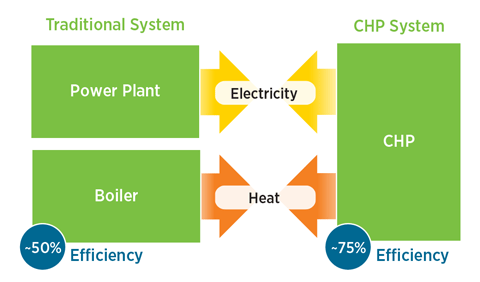
Source: Department of Energy, http://www.energy.gov/eere/amo/combined-heat-and-power-basics
The Department of Energy defines Combined Heat-Power (CHP) as the concurrent production of electricity or mechanical power and useful thermal energy (heating and/or cooling) from a single source of energy. Simply put, CHP systems use the waste heat associated with generating on-site electricity for some other useful purpose. By using this waste heat for a secondary application, CHP systems maximize the efficiency of the input fuel by simultaneously achieving multiple objectives. In other words, CHP systems give you more bang for your energy dollar.
There are various types of businesses that use CHP systems, most of which are used in commercial and industrial settings where waste heat can be used for some type of process application. In Florida, there are over 70 CHP sites, many of which can be found in the commercial and industrial sectors like chemical manufacturing, colleges & universities, food processing, hospitals & health care, nursing homes, pulp & paper facilities, and solid waste facilities and waste water treatment plants.
CHP installations in Florida total over 3,000 Megawatts of Capacity, most of which are generated from 6 types of mechanical devices that generate the on-site electricity, otherwise known as Prime Movers . These Prime Movers consist of Boiler/Steam Turbines, Combined Cycle systems (which use a Heat Recovery steam generator), Combustion Turbines, Micro Turbines, Reciprocating Engines, and Waste Heat Power systems that capture discarded heat from industrial processes.
Compared to renewables like wind or solar, CHP systems for the most part fly under the radar. This is particularly confounding because CHP systems are in many ways more beneficial for commercial and industrial applications than traditional renewable energy systems. For example, when compared to renewable systems, CHP technologies offer much greater reliability during periods of peak demand, generate significantly higher electrical output, allow buildings to operate independent of the power grid, and never experience intermittency.
In addition to increasing energy efficiency and lowering operating costs of a facility, CHP systems also contribute to lower emissions. The Environmental Protection Agency (EPA) is a strong supporter of CHP systems as evidenced in a 2012 report titled Combined Heat and Power: A Clean Energy Solution, where the EPA claims that a 50% increase in CHP systems within a 10 year time frame would yield a savings of 150 million metric tons of CO2 (the equivalent of removing 25 million cars of the road).
To summarize, installing CHP systems into commercial and industrial operations increase the energy efficiency and energy reliability, lowers operating costs and emissions, strengthen resiliency, and most important of all, ensures that your business maximizes the value of every dollar spent on heat energy.
For more information about potential CHP options at your facility, click below to submit a request. You will receive a call from our FPU Representative.


